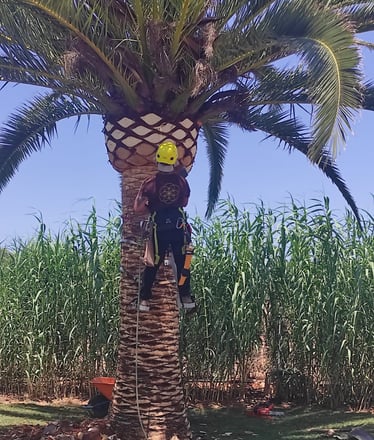Pruning the Canary Island Date Palm (Phoenix canariensis): How to Care for This Garden Gem


The Phoenix canariensis, or Canary Island date palm, is one of the most cherished species in Mediterranean landscaping. With its majestic stature and feather-like leaves, it adds a touch of elegance and exoticism to any outdoor space. Proper care and pruning are essential to keep these palms healthy and ensure optimal growth.
In this post, we will explore the importance of this palm, its key parts, and the steps for effective and safe pruning.
1. Importance of the Phoenix canariensis in the Garden
The Phoenix canariensis is a robust and decorative palm, ideal for gardens and spacious areas. Its ability to withstand drought and heat makes it particularly suited to the Mediterranean climate. Additionally, its size and shape make it a focal point in landscape design, standing out in parks, private gardens, and urban areas.
To ensure its impressive appearance remains an asset rather than a problem, it is essential to understand its main parts and how to care for them properly.
2. Main Parts of the Phoenix canariensis
Trunk (Stipe): Tall and upright, the trunk grows over the years and displays a distinctive texture due to the scars left by fallen leaves.
Leaves (Fronds): Long, arched, and pinnate, they form a spectacular crown at the top of the trunk. Young leaves are bright green, while older ones turn yellow or brown.
Crown: The cluster of leaves at the top of the trunk. It is essential for photosynthesis and the overall health of the palm, so pruning must be done carefully.
Flowers and Fruits: While its flowers and fruits are not as striking as its foliage, they can appear in the crown. The orange-colored fruits may drop if not removed in time.
3. How to Properly Prune the Phoenix canariensis
Proper pruning is key to keeping the palm in good condition and preventing it from becoming a burden in the garden. Follow these steps for the best results:
A. Removing Dry or Damaged Leaves
Eliminating dead, dry, or diseased leaves improves the palm’s aesthetics and prevents the spread of disease. It is important not to cut young or healthy leaves, as they are essential for photosynthesis and overall plant health.
B. Pruning Lower Leaves
As the palm grows, the lower leaves tend to dry out or fall. Removing them helps maintain a clean appearance and prevents the accumulation of pests or moisture. It is best to do this only when they are completely dry or damaged.
C. Maintaining Symmetry and Shape
If lateral shoots or disorganized growths appear, it is best to remove them to ensure a balanced shape. Over-pruning can negatively affect the palm’s healthy growth.
D. Using the Right Tools
To prune a Phoenix canariensis, use clean and sharp tools, such as saws and pruning shears. Make clean cuts to avoid tears that could allow pathogens to enter. Clean tools after each use to prevent the spread of disease.
4. Post-Pruning Care
After pruning, water the palm well to aid its recovery. It is also advisable to apply a balanced fertilizer to stimulate the growth of new leaves and strengthen its health. Regularly inspect the palm for signs of disease or pests.
5. When to Avoid Pruning
While pruning is essential, there are times when it is best to avoid it:
During the hottest months or in the active growth season, as the palm may become stressed.
Avoid removing too many leaves at once, as this can affect its ability to photosynthesize.
Conclusion
The Phoenix canariensis can be a stunning feature in any garden if properly cared for. Well-executed pruning helps keep the palm healthy, visually appealing, and free from pests. By understanding its structure and following the correct pruning steps, you can enjoy its beauty and grandeur for many years to come.
